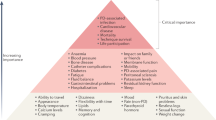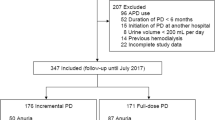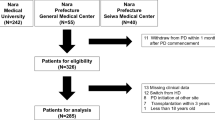Abstract
Peritoneal dialysis is the preferred chronic dialysis modality for most children owing to its almost universal applicability and superior compatibility with lifestyle over other modalities. Although technological advances and increasing clinical experience have impacted favorably on patient and technique survival, clinical research in pediatric peritoneal dialysis has been hampered by the low incidence of end-stage renal disease (ESRD) in the pediatric population. To overcome this limitation, several international registries have emerged in the past few years to complement other long-standing registries, which together have provided useful information regarding technique-specific complications and comorbidities associated with ESRD in children undergoing chronic peritoneal dialysis. In this Review, we summarize the most relevant findings from these studies, highlighting the substantial variation in patient conditions, peritoneal dialysis practices and management of comorbidities encountered in different parts of the world.
Key Points
-
Infection, ultrafiltration failure and adhesions are the most common causes of technique failure in children receiving peritoneal dialysis
-
Marked regional variation exists regarding the spectrum and antibiotic susceptibility patterns of bacteria causing peritonitis associated with peritoneal dialysis in children
-
The prevalence of hyperphosphatemia, severe hyperparathyroidism and bone disease in children on peritoneal dialysis shows marked global variation, being highest in the Americas and lowest in Asia and Europe
-
Early enteral feeding improves weight gain and can cause obesity in infants on peritoneal dialysis, but its efficacy in preventing growth failure is limited
-
Arterial hypertension is present in two-thirds of children undergoing chronic peritoneal dialysis and uncontrolled hypertension in one-third of these children
-
Left ventricular hypertrophy is present in 50% of children undergoing chronic peritoneal dialysis; fluid overload, hypertension and hyperparathyroidism are the most important risk factors for left ventricular hypertrophy
This is a preview of subscription content, access via your institution
Access options
Subscribe to this journal
Receive 12 print issues and online access
$209.00 per year
only $17.42 per issue
Buy this article
- Purchase on Springer Link
- Instant access to full article PDF
Prices may be subject to local taxes which are calculated during checkout





Similar content being viewed by others
References
Harambat, J., van Stralen, K. J., Kim, J. J. & Tizard, E. J. Epidemiology of chronic kidney disease in children. Pediatr. Nephrol. http://dx.doi.org/10.1007/s00467-011-1939-1.
International Pediatric Peritoneal Dialysis Network. About IPPN [online], (2011).
North American Pediatric Renal Trials and Collaborative Studies. NAPRTCS 2011 Annual Dialysis Report [online], (2011).
National Kidney Foundation. KDOQI Clinical Practice Guidelines and Clinical Practice Recommendations for 2006 Updates. Hemodialysis Adequacy, Peritoneal Dialysis Adequacy, Vascular Access. Am. J. Kidney Dis. 48 (Suppl. 1), S1–S322 (2006).
Warady, B. A., Alexander, S. R., Watkins, S., Kohaut, E. & Harmon, W. E. Optimal care of the pediatric end-stage renal disease patient on dialysis. Am. J. Kidney Dis. 33, 567–583 (1999).
Hari, P. et al. Chronic renal failure in children. Indian Pediatr. 40, 1035–1042 (2003).
Wang, T. & Wan, H. Y. Peritoneal dialysis in China: problem and prospects [Chinese]. Chin. J. Intern. Med. 42, 757–759 (2003).
Xu, H. & Bagga, A. in Pediatric Dialysis 2nd edn (eds Warady, B. A., Schaefer, F. & Alexander, S. R.) (Springer, in press).
Alexander, S. R., Salusky, I. B., Warady, B. A. & Watkins, S. L. Peritoneal dialysis workshop: pediatrics recommendations. Perit. Dial. Int. 17 (Suppl. 3), S25–S27 (1997).
Salusky, I. B. & Holloway, M. Selection of peritoneal dialysis for pediatric patients. Perit. Dial. Int. 17 (Suppl. 3), S35–S37 (1997).
Warady, B. A., Schaefer, F., Alexander, S. R., Firanek, C. & Mujais, S. in Care of the pediatric patient on peritoneal dialysis: clinical process for optimal outcomes (brochure). (Baxter Healthcare Corporation, McGaw Park, 2004).
Al-Hermi, B. E., Al-Saran, K., Secker, D. & Geary, D. F. Hemodialysis for end-stage renal disease in children weighing less than 10 kg. Pediatr. Nephrol. 13, 401–403 (1999).
Kovalski, Y., Cleper, R., Kruse, I. & Davidovits, M. Hemodialysis in children weighing less than 15 kg: a single-center experience. Pediatr. Nephrol. 22, 2105–2110 (2007).
Eisenstein, I. et al. Low infection rates and prolonged survival times of hemodialysis catheters in infants and children. Clin. J. Am. Soc. Nephrol. 6, 793–798 (2011).
Wisanuyotin, S. et al. Complications of peritoneal dialysis in children with Eagle-Barrett syndrome. Pediatr. Nephrol. 18, 159–163 (2003).
Honda, M. & Warady, B. A. Long-term peritoneal dialysis and encapsulating peritoneal sclerosis in children. Pediatr. Nephrol. 25, 75–81 (2010).
Verrina, E. et al. A multicenter experience on patient and technique survival in children on chronic dialysis. Pediatr. Nephrol. 19, 82–90 (2004).
Vidal, E. et al. on behalf of Italian Registry of Paediatric Chronic Dialysis. Peritoneal dialysis in infants: the experience of the Italian Registry of Paediatric Chronic Dialysis. Nephrol. Dial. Transplant. http://dx.doi.org/10.1093/ndt/gfr322.
US Renal Data System. USRDS 2009 Annual Data Report: Atlas of Chronic Kidney Disease and End-Stage Renal Disease in the United States [online], (2009).
McDonald, S. P. & Craig, J. C. for the Australian and New Zealand Paediatric Nephrology Association. Long-term survival of children with end-stage renal disease. N. Engl. J. Med. 350, 2654–2662 (2004).
Chadha, V., Schaefer, F. S. & Warady, B. A. Dialysis-associated peritonitis in children. Pediatr. Nephrol. 25, 425–440 (2010).
US Renal Data System. USRDS 2007 Annual Report: Atlas of Chronic Kidney Disease and End-Stage Renal Disease in the United States [online], (2007).
Bordador, E. B. et al. on behalf of the Australian and New Zealand Dialysis and Transplant Registry. Epidemiology and outcomes of peritonitis in children on peritoneal dialysis in Australasia. Pediatr. Nephrol. 25, 1739–1745 (2010).
Zelenitsky, S. et al. Analysis of microbiological trends in peritoneal dialysis-related peritonitis from 1991 to 1998. Am. J. Kidney Dis. 36, 1009–1013 (2000).
Piraino, B., Bernardini, J., Florio, T. & Fried, L. Staphylococcus aureus prophylaxis and trends in gram-negative infections in peritoneal dialysis patients. Perit. Dial. Int. 23, 456–459 (2003).
Warady, B. A. et al. for the International Pediatric Peritonitis Registry (IPPR). Peritonitis in children who receive long-term peritoneal dialysis: a prospective evaluation of therapeutic guidelines. J. Am. Soc. Nephrol. 18, 2172–2179 (2007).
Schaefer, F. et al. Worldwide variation of dialysis-associated peritonitis in children. Kidney Int. 72, 1374–1379 (2007).
Piraino, B. et al. for the ISPD Ad Hoc Advisory Committee. Peritoneal dialysis-related infections recommendations: 2005 update. Perit. Dial. Int. 25, 107–131 (2005).
Li, P. K. et al. Peritoneal dialysis-related infections recommendations: 2010 update. Perit. Dial. Int. 30, 393–423 (2010).
Warady, B. A., Hébert, D., Sullivan, E. K., Alexander, S. R. & Tejani, A. Renal transplantation, chronic dialysis, and chronic renal insufficiency in children and adolescents. The 1995 Annual Report of the North American Pediatric Renal Transplant Cooperative Study. Pediatr. Nephrol. 11, 49–64 (1997).
Furth, S. L., Donaldson, L. A., Sullivan, E. K. & Watkins, S. L. for the North American Pediatric Renal Transplant Cooperative Study. Peritoneal dialysis catheter infections and peritonitis in children: a report of the North American Pediatric Renal Transplant Cooperative Study. Pediatr. Nephrol. 15, 179–182 (2000).
Warady, B. A. et al. for the International Society for Peritoneal Dialysis (ISPD) Advisory Committee on Peritonitis Management in Pediatric Patients. Consensus guidelines for the treatment of peritonitis in pediatric patients receiving peritoneal dialysis. Perit. Dial. Int. 20, 610–624 (2000).
von Schnakenburg, C. et al. Percutaneous endoscopic gastrostomy in children on peritoneal dialysis. Perit. Dial. Int. 26, 69–77 (2006).
Bernardini, J., Price, V. & Figueiredo, A. for the International Society for Peritoneal Dialysis (ISPD) Nursing Liaison Committee. Peritoneal dialysis patient training, 2006. Perit. Dial. Int. 26, 625–632 (2006).
Bernardini, J., Price, V., Figueiredo, A., Riemann, A. & Leung, D. International survey of peritoneal dialysis training programs. Perit. Dial. Int. 26, 658–663 (2006).
Adderson, E. E., Flynn, P. M. & Hoffman, J. M. Efficacy and safety of cefepime in pediatric patients: a systematic review and meta-analysis. J. Pediatr. 157, 490–495 (2010).
Rinaldi, S. et al. for the Italian Registry of Pediatric Chronic Peritoneal Dialysis. Chronic peritoneal dialysis catheters in children: a fifteen-year experience of the Italian Registry of Pediatric Chronic Peritoneal Dialysis. Perit. Dial. Int. 24, 481–486 (2004).
Aksu, N. et al. A ten-year single-centre experience in children on chronic peritoneal dialysis—significance of percutaneous placement of peritoneal dialysis catheters. Nephrol. Dial. Transplant. 22, 2045–2051 (2007).
Bernardini, J. et al. Randomized, double-blind trial of antibiotic exit site cream for prevention of exit site infection in peritoneal dialysis patients. J. Am. Soc. Nephrol. 16, 539–545 (2005).
Chua, A. N., Goldstein, S. L., Bell, D. & Brewer, E. D. Topical mupirocin/sodium hypochlorite reduces peritonitis and exit-site infection rates in children. Clin. J. Am. Soc. Nephrol. 4, 1939–1943 (2009).
Warady, B. A. et al. Peritoneal membrane transport function in children receiving long-term dialysis. J. Am. Soc. Nephrol. 7, 2385–2391 (1996).
Twardowski, Z. et al. Peritoneal equilibration test. Perit. Dial. Bull. 7, 138–147 (1986).
Schaefer, F., Langenbeck, D., Heckert, K., Schärer, K. & Mehls, O. Evaluation of peritoneal solute transfer by the peritoneal equilibration test in children. Adv. Perit. Dial. 8, 410–415 (1992).
Kohaut, E. C., Waldo, F. B. & Benfield, M. R. The effect of changes in dialysate volume on glucose and urea equilibration. Perit. Dial. Int. 14, 236–239 (1994).
de Boer, A. W. et al. The necessity of adjusting dialysate volume to body surface area in pediatric peritoneal equilibration tests. Perit. Dial. Int. 17, 199–202 (1997).
Haraldsson, B. Assessing the peritoneal dialysis capacities of individual patients. Kidney Int. 47, 1187–1198 (1995).
Bouts, A. H. et al. Standard peritoneal permeability analysis in children. J. Am. Soc. Nephrol. 11, 943–950 (2000).
Fischbach, M. & Warady, B. A. Peritoneal dialysis prescription in children: bedside principles for optimal practice. Pediatr. Nephrol. 24, 1633–1642 (2009).
Fischbach, M., Stefanidis, C. J. & Watson, A. R. for the European Pediatric Peritoneal Dialysis Working Group. Guidelines by an ad hoc European committee on adequacy of the paediatric peritoneal dialysis prescription. Nephrol. Dial. Transplant. 17, 380–385 (2002).
Fischbach, M. & Haraldsson, B. Dynamic changes of the total pore area available for peritoneal exchange in children. J. Am. Soc. Nephrol. 12, 1524–1529 (2001).
Fischbach, M. et al. Measurement of hydrostatic intraperitoneal pressure: a useful tool for the improvement of dialysis dose prescription. Pediatr. Nephrol. 18, 976–980 (2003).
Fadrowski, J. J. et al. Children on long-term dialysis in the United States: findings from the 2005 ESRD Clinical Performance Measures Project. Am. J. Kidney Dis. 50, 958–966 (2007).
Morgenstern, B. Z., Mahoney, D. W. & Warady, B. A. Estimating total body water in children on the basis of height and weight: a reevaluation of the formulas of Mellits and Cheek. J. Am. Soc. Nephrol. 13, 1884–1888 (2002).
Blake, P. G. et al. for the Canadian Society of Nephrology Work Group on Adequacy of Peritoneal Dialysis. Clinical practice guidelines and recommendations on peritoneal dialysis adequacy 2011. Perit. Dial. Int. 31, 218–239 (2011).
Borzych, D. et al. for the International Pediatric PD Network (IPPN). The bone and mineral disorder of children undergoing chronic peritoneal dialysis. Kidney Int. 78, 1295–1304 (2010).
Klaus, G. et al. for the European Pediatric Dialysis Working Group (EPDWG). Prevention and treatment of renal osteodystrophy in children on chronic renal failure: European guidelines. Pediatr. Nephrol. 21, 151–159 (2006).
National Kidney Foundation. K/DOQI clinical practice guidelines for bone metabolism and disease in children with chronic kidney disease. Am. J. Kidney Dis. 46 (Suppl. 1), 12–100 (2005).
Waller, S., Shroff, R., Freemont, A. J. & Rees, L. Bone histomorphometry in children prior to commencing renal replacement therapy. Pediatr. Nephrol. 23, 1523–1529 (2008).
Ledermann, S. E., Spitz, L., Moloney, J., Rees, L. & Trompeter, R. S. Gastrostomy feeding in infants and children on peritoneal dialysis. Pediatr. Nephrol. 17, 246–250 (2002).
Rees, L. et al. for the International Pediatric Peritoneal Dialysis Network. Factors affecting growth in infants undergoing chronic peritoneal dialysis. J. Am. Soc. Nephrol. (in press).
Rabkin, R., Sun, D. F., Chen, Y., Tan, J. & Schaefer, F. Growth hormone resistance in uremia, a role for impaired JAK/STAT signaling. Pediatr. Nephrol. 20, 313–318 (2005).
Schaefer, F., Chen, Y., Tsao, T., Nouri, P. & Rabkin, R. Impaired JAK-STAT signal transduction contributes to growth hormone resistance in chronic uremia. J. Clin. Invest. 108, 467–475 (2001).
Haffner, D. et al. for the German Study Group for Growth Hormone Treatment in Chronic Renal Failure. Factors predictive of the short- and long-term efficacy of growth hormone treatment in prepubertal children with chronic renal failure. J. Am. Soc. Nephrol. 9, 1899–1907 (1998).
Schaefer, F., Wühl, E., Haffner, D. & Mehls, O. for the German Study Group for Growth Hormone Treatment in Chronic Renal Failure. Stimulation of growth by recombinant human growth hormone in children undergoing peritoneal dialysis or hemodialysis treatment. Adv. Perit. Dial. 10, 321–326 (1994).
Wühl, E., Haffner, D., Nissel, R., Schaefer, F. & Mehls, O. Short dialyzed children respond less to growth hormone than patients prior to dialysis. German Study Group for Growth Hormone Treatment in Chronic Renal Failure. Pediatr. Nephrol. 10, 294–298 (1996).
Bérard, E. et al. Recombinant human growth hormone treatment of children on hemodialysis. French Society of Pediatric Nephrology. Pediatr. Nephrol. 12, 304–310 (1998).
Chadha, V., Blowey, D. L. & Warady, B. A. Is growth a valid outcome measure of dialysis clearance in children undergoing peritoneal dialysis? Perit. Dial. Int. 21 (Suppl. 3), S179–S184 (2001).
Fine, R. N., Attie, K. M., Kuntze, J., Brown, D. F. & Kohaut, E. C. for the Genentech Collaborative Study Group. Recombinant human growth hormone in infants and young children with chronic renal insufficiency. Pediatr. Nephrol. 9, 451–457 (1995).
Mencarelli, F. et al. Growth hormone treatment started in the first year of life in infants with chronic renal failure. Pediatr. Nephrol. 24, 1039–1046 (2009).
Schaefer, F., Klaus, G. & Mehls, O. the Mid-European Pediatric Peritoneal Dialysis Study Group. Peritoneal transport properties and dialysis dose affect growth and nutritional status in children on chronic peritoneal dialysis. J. Am. Soc. Nephrol. 10, 1786–1792 (1999).
Denson, L. A. et al. Interleukin-6 inhibits hepatic growth hormone signaling via upregulation of Cis and Socs-3. Am. J. Physiol. Gastrointest. Liver Physiol. 284, G646–G654 (2003).
Chavers, B. M., Li, S., Collins, A. J. & Herzog, C. A. Cardiovascular disease in pediatric chronic dialysis patients. Kidney Int. 62, 648–653 (2002).
Parekh, R. S., Carroll, C. E., Wolfe, R. A. & Port, F. K. Cardiovascular mortality in children and young adults with end-stage kidney disease. J. Pediatr. 141, 191–197 (2002).
Mitsnefes, M. M. Cardiovascular complications of pediatric chronic kidney disease. Pediatr. Nephrol. 23, 27–39 (2008).
Wang, A. Y. et al. Inflammation, residual kidney function, and cardiac hypertrophy are interrelated and combine adversely to enhance mortality and cardiovascular death risk of peritoneal dialysis patients. J. Am. Soc. Nephrol. 15, 2186–2194 (2004).
Bakkaloglu, S. A. et al. Assessment of cardiovascular risk in paediatric peritoneal dialysis patients: a Turkish Pediatric Peritoneal Dialysis Study Group (TUPEPD) report. Nephrol. Dial. Transplant. 24, 3525–3532 (2009).
Kramer, A. M. et al. Demographics of blood pressure and hypertension in children on renal replacement therapy in Europe. Kidney Int. http://dx.doi.org/10.1038/ki.2011.232.
Mitsnefes, M. & Stablein, D. Hypertension in pediatric patients on long-term dialysis: a report of the North American Pediatric Renal Transplant Cooperative Study (NAPRTCS). Am. J. Kidney Dis. 45, 309–315 (2005).
Hölttä, T., Happonen, J. M., Rönnholm, K., Fyhrquist, F. & Holmberg, C. Hypertension, cardiac state, and the role of volume overload during peritoneal dialysis. Pediatr. Nephrol. 16, 324–331 (2001).
Bakkaloglu, S. A. et al. for the International Pediatric Peritoneal Dialysis Network. Cardiac geometry in children receiving chronic peritoneal dialysis: findings from the International Pediatric Peritoneal Dialysis Network (IPPN) Registry. Clin. J. Am. Soc. Nephrol. 6, 1926–1933 (2011).
Borzych, D. et al. for the International Pediatric PD Network (IPPN). Defining left ventricular hypertrophy in children on peritoneal dialysis. Clin. J. Am. Soc. Nephrol. 6, 1934–1943 (2011).
Mitsnefes, M. M. et al. Severe left ventricular hypertrophy in pediatric dialysis: prevalence and predictors. Pediatr. Nephrol. 14, 898–902 (2000).
Bakkaloglu, S. A. et al. Impact of peritoneal transport characteristics on cardiac function in paediatric peritoneal dialysis patients: a Turkish Pediatric Peritoneal Dialysis Study Group (TUPEPD) report. Nephrol. Dial. Transplant. 25, 2296–2303 (2010).
Urbina, E. M. et al. Effect of body size, ponderosity, and blood pressure on left ventricular growth in children and young adults in the Bogalusa Heart Study. Circulation 91, 2400–2406 (1995).
Mitsnefes, M. M. et al. Cardiac and vascular adaptation in pediatric patients with chronic kidney disease: role of calcium-phosphorus metabolism. J. Am. Soc. Nephrol. 16, 2796–2803 (2005).
Matteucci, M. C. et al. for the ESCAPE Trial Group. Left ventricular geometry in children with mild to moderate chronic renal insufficiency. J. Am. Soc. Nephrol. 17, 218–226 (2006).
Schlüter, K. D. & Piper, H. M. Trophic effects of catecholamines and parathyroid hormone on adult ventricular cardiomyocytes. Am. J. Physiol. 263, H1739–H1746 (1992).
Amann, K., Ritz, E., Wiest, G., Klaus, G. & Mall, G. A role of parathyroid hormone for the activation of cardiac fibroblasts in uremia. J. Am. Soc. Nephrol. 4, 1814–1819 (1994).
Piovesan, A. et al. Left ventricular hypertrophy in primary hyperparathyroidism. Effects of successful parathyroidectomy. Clin. Endocrinol. (Oxf.) 50, 321–328 (1999).
Author information
Authors and Affiliations
Contributions
F. Schaefer and B. A. Warady contributed equally to discussion of content for the article, researching data to include in the manuscript and reviewing and editing of the manuscript before submission.
Corresponding author
Ethics declarations
Competing interests
F. Schaefer has received a grant/research support from Fresenius Medical Care. B. A. Warady has received a grant/research support from Baxter Healthcare.
Rights and permissions
About this article
Cite this article
Schaefer, F., Warady, B. Peritoneal dialysis in children with end-stage renal disease. Nat Rev Nephrol 7, 659–668 (2011). https://doi.org/10.1038/nrneph.2011.135
Published:
Issue Date:
DOI: https://doi.org/10.1038/nrneph.2011.135
This article is cited by
-
Epidemiology of peritoneal dialysis outcomes
Nature Reviews Nephrology (2022)
-
Unconventional T cells and kidney disease
Nature Reviews Nephrology (2021)



